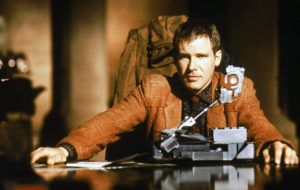I was walking through the chaos of Times Square recently when, in search of some minor relief, I reflexively raised my head and focused on a space in the middle distance where I have been conditioned to expect the calming sight of beautiful young bodies in white underwear, courtesy of Calvin Klein. The image that struck me had the familiar soothing grey tones of the company’s distinctive neo-Hellenistic ad campaigns, pioneered by the photographer Bruce Weber. By then, I had stopped walking, as my brain was fully occupied with the futile activity of trying to erase what I had seen: two miserable-looking people of quasi-indeterminate gender, their middle-aged bellies spilling over the elastic of their underwear.
The joke was on me, I thought. Or maybe the joke was on Calvin Klein. Faced with a grotesque sight that I could just as easily have viewed in my own bathroom mirror, I resolved to eat less and exercise more often — and to stop buying Calvins.
But was the billboard actually a joke? On reflection, I had my doubts. If there is one aesthetic experience that defines the present, it is the feeling of being under more or less constant attack by the anti-beauty impulse — the kind of deliberate ugliness that I saw on the billboard. Examples of this style of defacement are everywhere, and particularly in commercial ad campaigns, from Calvin Klein ads to the cover of Sports Illustrated. Their omnipresence suggests that something more radical is afoot than an attempt to expand beauty standards by, say, showing us that men and women of different races, genders and sexual preferences might all partake of a common, more inclusive set of ideals. There is in fact an overriding difference between appreciating the beauty of men and women of different races and physical types, which at this point in history seems like a lesson that adequately-educated
The anti-beauty impulse is iconoclastic, not in the playful mid-20th-century sense, but in the literal sense of destroying icons. It is dour, tight-lipped and totalising. Sex is forbidden, as are desire, playfulness, and pleasure. What’s left is the feeling of someone spitting in your face and forbidding you from wiping it off. The aim of such gestures is not to expand anyone’s aesthetic. It is to punish you for being attracted to what is now forbidden.
Iconoclasm has its own history. A few years ago, I visited John Calvin’s church in Geneva, whose brutalist interior was achieved by smashing the statues that had once been inside. I am not a Catholic and have only a passing acquaintance with the glories of Renaissance art, but still, it was hard not to feel the destructive force that had been unleashed in the interior of what had once been the city’s largest cathedral, even as a children’s choir sang hymns in the background. As the authors of that particular bout of heady vandalism no doubt intended, it was not a particularly peaceful or pleasant experience. I couldn’t wait to get out of there.
The idea that destruction should be pursued programmatically, as a virtue, with beauty as the enemy, is what separates puritanism from punk, an aggressive aesthetic that rejected prevailing standards of beauty and other norms and instead sought to release energy by smashing things. Punk was a studiously primitive expression of the life-force. The Calvinist vandals of Geneva, like their latter-day successors in the Taliban, sought to repress the life-force by denying the validity of any experience or standard outside their own fixed notions of virtue.
The assault on beauty that we are seeing today is more puritan than punk; its authors defend their actions as expressions of the millenarian urgency of their supposedly secular beliefs. When climate activists deface paintings by Monet, Klimpt, Vermeer, Picasso, Van Gogh and others, they are not merely attacking paintings; they are saving the planet. Activists in the United States who tear down sculptures memorialising Confederate war dead are not merely attacking works of art, or rejecting the achievement of peace between warring sectional armies; they are posing as warriors locked in a death-struggle with racism and white supremacy. Putting photographs of overweight women, or trans women, on the covers of men’s magazines is said to be a way of fighting misogyny or saving trans lives, even as it is also obviously a way of expressing contempt for the readers of those magazines and the universe of desire they inhabit.
The motivation behind these acts would be recognisable to the inhabitants of Calvin’s Geneva: to attack images and objects considered by others to be beautiful or sacred. Why beauty should find itself the target of a culture-wide rage for destruction is a question to which no single answer is likely to suffice. A short list of such candidates might include: widespread feelings of misery and powerlessness caused by rampant inequality; the disillusioning reach and effect of new technologies; and the desire to build a better world, save the planet, and put an end, once and for all, to racism, sexism, homophobia, misogyny and other barriers to equality.
A more sweeping answer can be found in the Russian science-fiction novel We, written nearly a century ago by Yevgeny Zamyatin. We is set in a future utopia run by engineers whose rage for equality mediated by algorithms would be familiar to many of today’s puritanical activists. The novel is presented as the diary of a state mathematician named D-503, who falls in love with a woman named I-330, whose particular combination of black eyes, white skin, and black hair strike him as beautiful. D-503’s feelings of attraction for I-330, and his desire for an exclusive relationship with her, in turn draw him into a conspiracy against “the Only State”. Zamyatin’s totalising utopia is a centralised surveillance state governed according to a highly-advanced mathematics of happiness incarnated in the Integral, a giant computing machine/spaceship that will soon “force into the yoke of reason other unknown beings that inhabit other planets, perhaps still in a wild state of freedom”.
Love has been banned by the Only State as inherently discriminatory and unjust. Sex has not. According to the Lex Sexualis, the government sex code: “Each number has a right towards every other number as a sex object.” Citizens are issued ration books of sex tickets. Once both numbers sign the ticket, they are permitted to spend a “sex hour” together and to lower the shades in their glass apartments, becoming temporarily invisible to surveillance, which is how the romance between D-503 and I-330 begins.
We is chiefly known today in the West as the inspiration for Orwell’s most famous anti-utopian fiction, 1984. Orwell’s reading of We was heavily coloured by his revulsion for both the fascist and communist real-world versions of the one-party state, which he had come to loathe during the Spanish Civil War. “The guiding principle of the State is that happiness and freedom are incompatible,” Orwell wrote in his 1946 review of We. “Now the Single State has restored [mankinds’s] happiness by removing his freedom.”
Yet key aspects of Zamyatin’s book puzzled Orwell. “Writing at about the time of Lenin’s death, he cannot have had the Stalin dictatorship in mind, and conditions in Russia in 1923 were not such that anyone would revolt against them on the ground that life was becoming too safe and comfortable,” Orwell observed. “What Zamyatin seems to be aiming at is not any particular country,” he concluded, “but the implied aims of industrial civilization.”
Yes, but. If the opposition between happiness and freedom that Orwell found in We became the central theme of 1984, Zamyatin had introduced a third term, which he believed to be more revolutionary and also more inherently human than the desire for freedom: Beauty.
By eliminating freedom and all causes of inequality and envy, the Only State claimed to guarantee infinite happiness. The real threat to this ideal isn’t sexual envy, which is rampant in the Only State, or the existence of an invisible elite that in fact rules the city. It’s beauty. For D-503, dance is beautiful, mathematics is beautiful, and the contrast between I-330’s black eyes and black hair and white skin is beautiful. Beauty is the answer to D-503’s urgent question, “What is there beyond?”
The subjective human perception of beauty, Zamyatin argued, was not reconcilable with utilitarian calculations of social justice. Beauty is unequally distributed, and therefore manifestly unjust. At the same time, no one loses anything because someone or something outside themselves is considered beautiful by others. My perceptions of beauty in a person or a piece of music are entirely my own, yet at the same time they in no way preclude others from the same enjoyment; the enjoyment of beauty is therefore at the same time wildly unequal yet universally available.
Beauty, Zamyatin believed, was an inherently stubborn human force that is rooted in our biology, and therefore in external absolutes, like the mathematical ratios that determine D-503’s perceptions of the beauty of I-330’s face, which are at the same time both fixed and irrational. It is something real we perceive in the world, and not, or not merely, an arbitrary “construct” determined by power relations. The ultimate example of human un-freedom and un-reason, beauty is key to our humanity.
Human beings want what we want because we are human. Therefore, we will never stop seeking beauty, and will reject and destroy any attempt to reorder our desires according to the logic of machines. Machines can be programmed to weigh out exact measures of equality, but they can’t be programmed to feel what humans feel when looking at other humans in their underwear. Nor can machines feel envy, spite, or the impulse to desecrate things that other people find beautiful.
It is no accident, then, that in a moment when Zamyatin’s vision of a technologically-advanced society whose chief value is equality seems to be within our reach, that beauty would present itself as an obstacle to that vision — and as a primary target of egalitarian rage.
Disclaimer
Some of the posts we share are controversial and we do not necessarily agree with them in the whole extend. Sometimes we agree with the content or part of it but we do not agree with the narration or language. Nevertheless we find them somehow interesting, valuable and/or informative or we share them, because we strongly believe in freedom of speech, free press and journalism. We strongly encourage you to have a critical approach to all the content, do your own research and analysis to build your own opinion.
We would be glad to have your feedback.
Source: UnHerd Read the original article here: https://unherd.com/





